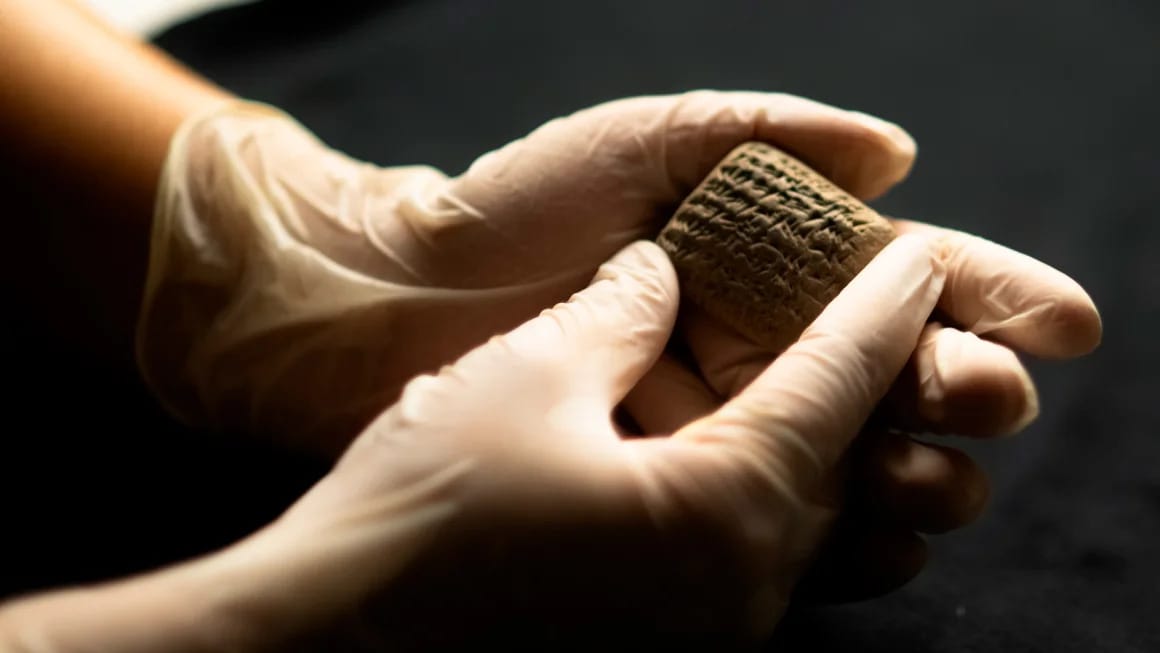Archaeologists unearth tiny 3,500-year-old clay tablet following an earthquake
“We believe that this tablet, weighing 28 grams, will provide a new perspective in terms of understanding the economic structure and state system of the Late Bronze Age,” said Mehmet Ersoy, Turkey’s minister of culture and tourism, in a statement.

Archaeologists have uncovered a tiny 3,500-year-old tablet inscribed with cuneiform writing during excavations at a site in Turkey that could shed light on what life was like during the Late Bronze Age.
Cuneiform, one of the oldest forms of writing, was used across the ancient Middle East.
Cuneiform recorded Sumerian, Akkadian, and other languages of Mesopotamia, the region where the world’s earliest known civilization developed that’s now modern-day Iraq. Highly educated scribes created the distinctive wedge-shaped characters using reeds on clay tablets.
The newly found tablet, which dates back to the 15th century BC, appears to have served as an itemized receipt. Written in Akkadian cuneiform, the ancient inscription describes the purchase of a large amount of furniture.
“We believe that this tablet, weighing 28 grams, will provide a new perspective in terms of understanding the economic structure and state system of the Late Bronze Age,” said Mehmet Ersoy, Turkey’s minister of culture and tourism, in a statement.
The tablet only measures 1.7 inches by 1.4 inches (4.2 centimeters by 3.5 centimeters) in size with a thickness of 0.6 inches (1.6 centimeters). Researchers found the artifact outside of the gate of the ancient city Alalakh, now known as the Tell Atchana archaeological mound and site.

But perhaps more surprising is that the tiny tablet was found in July during restoration work after devastating earthquakes. In the aftermath of the natural disaster, archaeology became a form of recovery and healing for the community, said excavation leader Dr. Murat Akar.
An ancient furniture order
British archaeologist Sir Leonard Woolley first excavated the city of Alalakh in the 1930s. He discovered an archive of cuneiform tablets in a fortress that adjoins the gate, said Dr. Jacob Lauinger, associate professor of Assyriology at the Johns Hopkins University in Baltimore.
“The new tablet comes from either that same archive of tablets or a different unexcavated one in the fortress, and it washed down to the gate at some point,” Lauinger said.
Lauinger and Zeynep Türker, a doctoral student in Johns Hopkins’ department of Near Eastern studies, are currently translating and studying the tablet with Akar, who is an associate professor within the department of archaeology at the Mustafa Kemal University in Turkey.
The findings will be published in a peer-reviewed study led by Türker, but so far, their translation of the tablet reveals the purchase of roughly 200 or more wooden tables, chairs and stools. While other tablets from Alalakh mention the production of furniture at the site, nothing has reached the scale of those listed on the newly discovered tablet, Lauinger said.

The team is studying the tablet’s connections to other tablets excavated by Woolley, as well as cuneiform tablets that mention furniture from other Late Bronze Age sites.
Administrative texts, such as the one found at Alalakh, recorded the number of raw materials and finished products that palace workers created, distributed and used, he said.
“For this reason, they provide incredible insights into the ancient society and economy of Alalakh — we are literally reading the bookkeeping accounts of an ancient accountant from almost 3,500 years ago!” Lauinger said in an email.
But the team is also trying to discern how the tablet fits into the broader context of the society living within the ancient city at the time. The researchers believe the furniture was constructed around the same time rather than in batches of small orders that accumulated over time. Now, the team wants to explore the different historical scenarios that would have required so many pieces of furniture.
“Was it for some special occasion at Alalakh like a royal marriage?” Lauinger said. “Could it have been for a religious festival? Was Alalakh producing furniture for export? Hopefully we will be able to start to rule out some of these scenarios and thereby make the case for other ones as having been more likely.”





